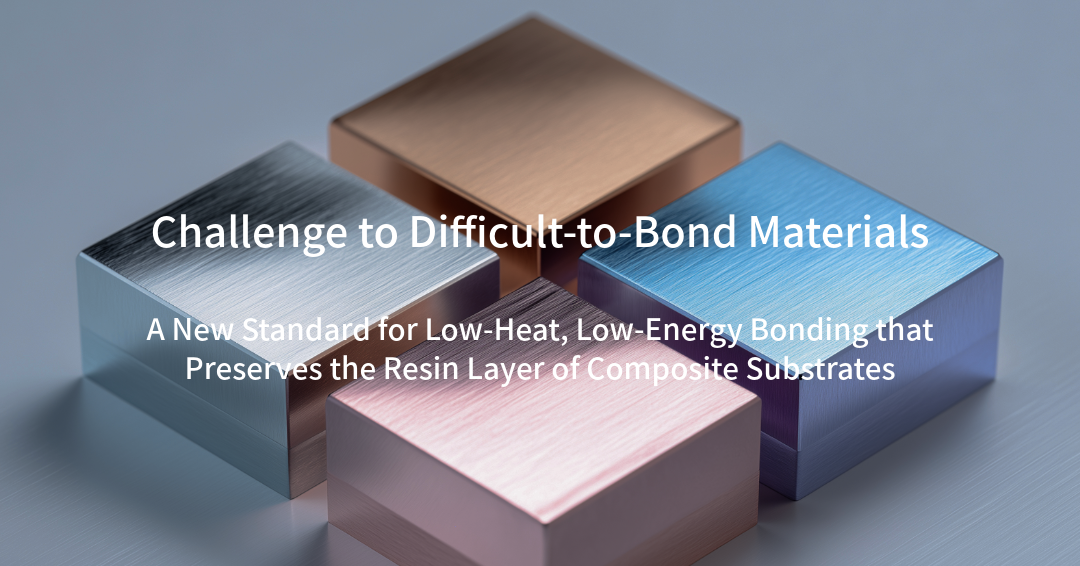Continuing our discussion on polymers, this time we focus on bonding composite substrates, a highly relevant material in modern manufacturing.
The use of composite substrates—metals coated (plated) onto a polymer—is expanding due to the need for lighter Secondary Battery cells and miniaturized electronic devices. These materials combine the conductivity of metal with the flexibility and insulation of the polymer, making them ideal for applications like electrode plates.
Ultrasonic bonding is the technology drawing attention for these substrates. Welding or soldering composite materials is extremely difficult because the heat input deforms or burns the polymer layer, leading to a loss of material properties. Composite substrates are delicately engineered, often with metal layers only a few microns thick and polymer layers around , demanding damage-free bonding.
The Ultrasonic Complex Vibration Bonding (UCVB) technology developed by LINK-US is gaining recognition as the unique, innovative bonding method that can satisfy both peel strength and electrical conductivity requirements.
table of contents
The Challenge of Composite Substrate Bonding
The composite substrates discussed here are manufactured by laminating metal (Cu, Al, Ni, etc.) onto a resin (polymer, insulating layer). This structure introduces several bonding problems:
- Polymer Layer Destruction by Heat: Laser or soldering creates localized high temperatures that carbonize the resin.
- Layer Delamination: Differences in thermal expansion cause the metal and resin layers to separate.
- Difficulty in Ensuring Conductivity: Resin residue remains at the interface, significantly increasing resistance.
- Increased Process Steps: Requires the additional step of scraping off the resin layer before re-bonding.
In particular, for high-current automotive components and power module substrates, these issues lead to insufficient reliability and low yield rates, creating a major obstacle to mass production.
LINK-US Solution: Low-Heat, Low-Energy Solid-State Bonding
UCVB utilizes the complex ultrasonic vibration to generate fine friction and plastic flow at the contact interface. This process displaces the surface resin and oxide film, directly joining the metals at an atomic level.
The results are striking:
- Polymer Layer Preservation: Maintains the entire layer's mechanical properties.
- Minimal Thermal Impact: Low localized temperature rise prevents carbonization and delamination.
- Highly Conductive Bonding: Eliminates resin residue, enabling stable current transfer with low resistance.
- Versatile Material Compatibility: Can bond dissimilar composite materials like Cu–Al and Cu–Ni clad.
UCVB establishes a new bonding standard for composite substrates that were previously considered "difficult to join due to thermal sensitivity."
Application Examples
- Automotive Power Module Substrates: Bonding terminals to copper-resin laminated composite substrates while maintaining the resin insulating layer. Simultaneously achieves lighter weight and high dielectric strength.
- EV Motor Peripherals: Enables stable mass production of composite substrate parts exposed to vibration and high temperatures, significantly improving durability and lifespan.
- Industrial Electronic Substrates: Allows for the introduction of composite materials into high-current boards, expanding design flexibility and balancing cooling efficiency with reliability.
Effects and Benefits
- Improved Yield: Reduced defects from thermal destruction and delamination significantly stabilizes mass production.
- Cost Reduction: Elimination of pre-treatment and resin removal processes streamlines the manufacturing line.
- Enhanced Performance: Lower bonding resistance ensures stable performance even at high output.
- Design Liberalization: Designers can confidently adopt resin-containing composite substrates, broadening the scope for next-generation device design.
Future Outlook
The EV and renewable energy sectors demand continuous miniaturization, weight reduction, and efficiency improvements. The adoption of composite substrates will only increase, making "non-thermal bonding technology" essential.
LINK-US's UCVB is not just a manufacturing technique—it's a technology that can change design philosophy. It will expand the freedom of material selection, enabling the development of more efficient and sustainable products.
Summary
Composite substrates are indispensable for next-generation products, yet bonding has been a major barrier with conventional technologies. LINK-US's Ultrasonic Complex Vibration Bonding breaks through this barrier by achieving high-quality bonding with low heat and low energy, preserving the resin layer. This brings a "new standard" to the mass production floor.
→ If you have challenges with composite substrate bonding, contact LINK-US for a consultation.

